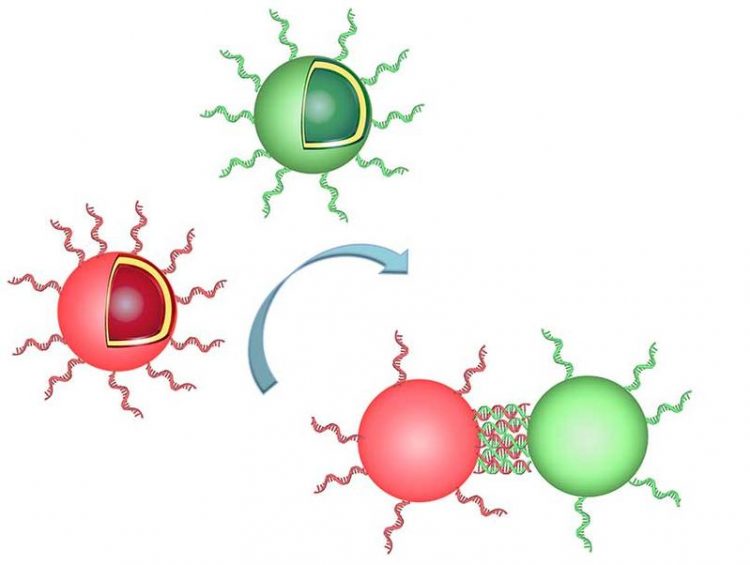Chemists Create Clusters of Organelles by Mimicking Nature

Two polymersomes assemble by DNA hybridization: the single DNA strands on the surface of the compartments interconnect, creating an extremely stable DNA bridge. University of Basel
Within a cell there are specialized compartments called organelles, as for example nucleus, mitochondria, peroxisomes and vacuoles that are responsible for specific functions of the cell. Almost all sophisticated biological functions of cells are realized by self-organization, a process by which molecules adopt a defined arrangement based on their specific conformations and properties, without outside guidance.
Using self-organization of nano-objects into complex architectures is a major strategy to produce new materials with improved properties or functionalities in fields such as chemistry, electronics and technology. For example, this strategy has already been applied to create networks of inorganic solid nanoparticles. However, so far, these networks were not able to mimic sophisticated structures that have biological functions within the cells and thus have potential application in medicine or biology.
DNA bridges give stability
The joint research of the groups led by the professors Cornelia Palivan and Wolfgang Meier now provides a new approach to self-organize artificial organelles into clusters that mimics the connection between their natural counterparts. By using single DNA strands to interconnect the spherical compartments the scientists succeeded in creating clusters according to a specific architecture and controlled properties. «We were excited to see, that the different DNA strands on the surface of the spherical compartment migrated together and formed a bridge with the DNA strands from the next one», says Palivan. This DNA bridge represents an extremely stable connection.
This strategy inspired by nature goes beyond the actual self-organization approaches, since it also allows the integration of various requirements such as the fine tuning of the distance between the compartments or different topologies “on demand”. As compartments, the scientists used polymersomes, with a synthetic membrane that, unlike liposomes, has the great advantage of being very stable and controlling the fusing of individual compartments within the cell.
An additional unique advantage of this strategy to organize nano-clusters is the fact that the compartments can be loaded with reaction partners such as enzymes, proteins or catalysts. This gives the basis for the further engineering of artificial organelles serving as molecular factories. This research was done within the National Centre of Competence in Research (NCCR) Molecular Systems Engineering.
Original source
Juan Liu, Viktoriia Postupalenko, Samuel Lörcher, Dalin Wu, Mohamed Chami, Wolfgang Meier, Cornelia G. Palivan
DNA-mediated self-organization of polymeric nanocompartments leads to interconnected artificial organelles
Nano Letters, 2016, Advance article: DOI :10.1021/nanolett.6b03430.
Further information
Cornelia G. Palivan, Universität Basel, Departement Chemie, Tel. +41 61 267 38 39. E-Mail: Cornelia.Palivan@unibas.ch
Media Contact
More Information:
http://www.unibas.chAll latest news from the category: Life Sciences and Chemistry
Articles and reports from the Life Sciences and chemistry area deal with applied and basic research into modern biology, chemistry and human medicine.
Valuable information can be found on a range of life sciences fields including bacteriology, biochemistry, bionics, bioinformatics, biophysics, biotechnology, genetics, geobotany, human biology, marine biology, microbiology, molecular biology, cellular biology, zoology, bioinorganic chemistry, microchemistry and environmental chemistry.
Newest articles

First-of-its-kind study uses remote sensing to monitor plastic debris in rivers and lakes
Remote sensing creates a cost-effective solution to monitoring plastic pollution. A first-of-its-kind study from researchers at the University of Minnesota Twin Cities shows how remote sensing can help monitor and…

Laser-based artificial neuron mimics nerve cell functions at lightning speed
With a processing speed a billion times faster than nature, chip-based laser neuron could help advance AI tasks such as pattern recognition and sequence prediction. Researchers have developed a laser-based…

Optimising the processing of plastic waste
Just one look in the yellow bin reveals a colourful jumble of different types of plastic. However, the purer and more uniform plastic waste is, the easier it is to…



